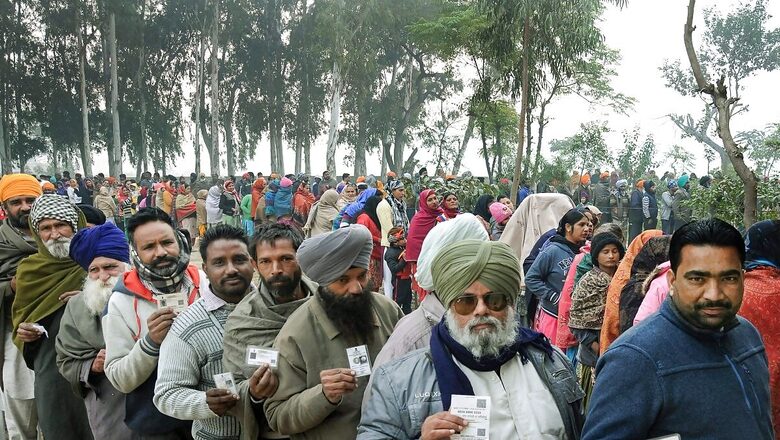
views
The state of Punjab has been in the political spotlight for more than half a century, initially for the green revolution and concomitant prosperity. In the last decade, it has been in the spotlight, unfortunately, due to the agrarian crisis, high levels of unemployment including youth, failed industrial policies and fiscal crisis. These reasons assumed centrality in the ongoing election campaign. Interestingly, these issues fall in the domain of the state.
In understanding and addressing issues, the primary sector of Punjab should take precedence for it ensures the food security of India. As a result of ensuring India’s food security, Punjab enjoys a high share of rice and wheat procurement in the central pool. The state, which is also known as the food bowl of India, is staring at a collapse of MSP-induced, cereal-centric crop husbandry due to stagnation in productivity, dangerous pace of depletion of water tables and deterioration of soil health.
It must be mentioned that the dangerous pace of depletion of water tables is driven by promises of free power from past and current governments. Similarly, the deterioration of soil health stems from the unchecked use of pesticides and subsidised fertilisers. The Punjab farmers have not yet come to terms with the impending collapse triggered long ago by assured procurement. Instead of addressing this core issue, they are demanding a legal guarantee for Minimum Support Price (MSP). It is not only inappropriate for the problem at hand but it would turn the impending collapse into an immediate one.
The Modi government’s decade-long focus on peasant farmers and sustainability initiatives offers hope for resolving Punjab’s agrarian crisis. Timely access to agricultural inputs, including mechanisation and services, has been ensured at stable prices through programs like PM Kisan and subsidised agricultural credit with interest subvention. Irrigation and warehousing infrastructure are being ramped up. Furthermore, initiatives like soil health cards and a dedicated mission mode focus on organic and natural farming are addressing soil deterioration while minimising input costs. The marketing landscape is also being broadened through continuous support for farmer-producer organisations and food processing.
Leveraging these initiatives in conjunction with the Modi government’s thrust on crop diversification, Punjab farmers can shift to pulses, oil seeds, millets, vegetables and fruits. In the course, water tables would be restored. They can also derive additional income from the livestock, fishing and aquaculture sub-sectors as their share in the agriculture and allied activities witnessed an increase between 2013-14 and 2022-23 nationally. To address climate change and increase productivity, India is also witnessing the rapid deployment of technology in agriculture which can reverse the Punjab’s youth disinterest in agriculture and partly address their unemployment.
When the Periodic Labour Force Survey (PLFS) series began, Punjab had the fifth-highest unemployment rate among larger states and the ninth-highest youth unemployment rate. However, the latest PLFS reveals a concerning trend: Punjab now has the second-highest unemployment rate overall, a position mirrored in its youth unemployment figures. This descent into crisis is a result of culmination of many factors.
Punjab’s economic challenges are multifaceted. First, the state grapples with an inverted economic structure, where agriculture and industry contribute roughly equal shares to the Gross State Domestic Product (GSDP). Second, the services sector lags behind the national average. Third, Punjab’s growth rate has trailed national figures over the past decade. Fourth, industrial and business development policies have failed to ignite significant economic activity. Fifth, successive state governments have shown a lack of commitment towards improving the ease of doing business and fostering a vibrant entrepreneurial ecosystem. Sixth, populist measures have led to unproductive fiscal expenditure. Finally and most perhaps importantly, non-BJP leadership has lacked the vision, direction, and political will to address these challenges effectively.
Why did the industrial policy fail and fiscal management descend into crisis – the last two of the election issues – which otherwise would aid a higher economic growth rate, address the high unemployment and partly, the agrarian crisis?
First, according to a popular analysis, the Punjab’s industrial policies of 2013, 2017 and 2022 failed to predict which industries would thrive. Second, they displayed a bias towards large-scale capital investments, neglecting the micro-enterprises crucial for generating widespread employment. Third, these policies did not derive support from the availability of proper infrastructure. This infrastructural deficit highlights poor fiscal expenditure choices, with all three Punjab governments over the last decade prioritising populist measures over essential development. The fiscal crisis has been an unfortunate outcome.
A similar situation reflecting the issues of Punjab’s election campaign except the agrarian crisis was staring at Narendra Modi when he took the baton in 2014 – plunging growth rates; weak external sector and banking sector; non-transparent and unproductive fiscal expenditure; declining labour market indicators; dearth of supportive ecosystem for corporates, MSMEs and startups; lack of price stability, policy stability and investor confidence; and the absence of a clear economic vision. In effect, he was greeted with an economy waiting to collapse.
A decade later, India has emerged as the world’s fastest-growing economy for three consecutive years. Fiscal and labour market indicators have shown marked improvement, alongside sectoral growth in banking, external trade, manufacturing, and MSMEs. Both global and domestic investors are now reaping the benefits of improved ease of doing business and promising growth prospects. To sustain this momentum and achieve even higher long-term growth, India is finalising its Vision 2047 document, building upon the successes of initiatives like Make in India and Atmanirbhar Bharat.
India’s potential to remain the fastest-growing major economy until 2030 and contribute 18 per cent to global growth over the next five years hinges on the growth of its individual states. Given that the combined GSDP of states forms a significant portion of India’s GDP, Punjab’s growth is crucial to national progress. For Punjab to contribute meaningfully, it must break free from its vicious cycle into a virtuous cycle and eventual prosperity.
It’s important to remember that just four decades ago, Punjab boasted the highest GDP per capita in India. To reignite this economic engine, the electorate could consider electing more representatives aligned with Modi’s vision.
Sandeep Vempati is an Economist & Columnist with the Bharatiya Janata Party. Views expressed in the above piece are personal and solely that of the author. They do not necessarily reflect News18’s views.




















Comments
0 comment